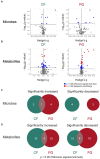The differential effect of two cereal foods on gut environment: a randomized, controlled, double-blind, parallel-group study
- PMID: 38455871
- PMCID: PMC10917986
- DOI: 10.3389/fnut.2023.1254712
The differential effect of two cereal foods on gut environment: a randomized, controlled, double-blind, parallel-group study
Abstract
Background and aims: Cereal-based foods such as fruit granola (FG) and corn flakes (CF) form part of a fiber-rich diet. Dietary fiber has a good effect on human health. However, changes in gut microbiota and intestinal immunity have not been investigated. We conducted a randomized, double-blind, placebo-controlled trial to investigate the effects of FG and CF intake on gut microbiota, metabolome, and the immune system.
Methods: Subjects continuously consume CF or FG for 4 weeks. Stool samples, and questionnaires on defecation were collected before, 2 weeks after, and 4 weeks after intake. Gut microbiota was analyzed using 16S rRNA gene amplicon sequencing. Fecal metabolomes were analyzed using GC/MS and CE-TOF/MS. Fecal IgA was analyzed using ELISA.
Results: The defecation frequency after cereal based food intake was improved. The different cereal-based foods had different effects on gut microbiome. The increase in intestinal IgA levels was positively correlated with the relative abundance of Dialister and the Lachnospiraceae ND3007 group in CF and FG group, respectively. SCFAs showed a positive correlation with Prevotella 9 in the FG group.
Conclusion: This study showed that the supplement in dietary fiber contained in CF and FG improves bowel movements. CF and FG each had different effects on gut microbes, metabolites and different relationships between fecal IgA or SCFAs and gut microbiota.
Keywords: corn flakes; defecation; dietary fiber; fruit granola; gut microbiota; short-chain fatty acids.
Copyright © 2024 Yamauchi, Masutomi, Ishihara, Hartanto, Lee and Fukuda.
Conflict of interest statement
YY, TH, and CL are employees of Metagen, Inc. SF is a founder of Metagen, Inc. HM and KI are employees of Calbee, Inc. This study received funding from Calbee, Inc. The funder had the following involvement with the study: Calbee, Inc. was involved in study design and review of the manuscript. All authors declare no other competing interests.
Figures






Similar articles
-
Effects of dietary fibers or probiotics on functional constipation symptoms and roles of gut microbiota: a double-blinded randomized placebo trial.Gut Microbes. 2023 Jan-Dec;15(1):2197837. doi: 10.1080/19490976.2023.2197837. Gut Microbes. 2023. PMID: 37078654 Free PMC article. Clinical Trial.
-
Dietary supplement of mushrooms promotes SCFA production and moderately associates with IgA production: A pilot clinical study.Front Nutr. 2023 Jan 9;9:1078060. doi: 10.3389/fnut.2022.1078060. eCollection 2022. Front Nutr. 2023. PMID: 36698463 Free PMC article.
-
Impact of wheat aleurone on biomarkers of cardiovascular disease, gut microbiota and metabolites in adults with high body mass index: a double-blind, placebo-controlled, randomized clinical trial.Eur J Nutr. 2022 Aug;61(5):2651-2671. doi: 10.1007/s00394-022-02836-9. Epub 2022 Mar 5. Eur J Nutr. 2022. PMID: 35247098 Free PMC article. Clinical Trial.
-
The Effects of Intact Cereal Grain Fibers, Including Wheat Bran on the Gut Microbiota Composition of Healthy Adults: A Systematic Review.Front Nutr. 2019 Mar 29;6:33. doi: 10.3389/fnut.2019.00033. eCollection 2019. Front Nutr. 2019. PMID: 30984765 Free PMC article.
-
The Role of Dietary Fibre in Modulating Gut Microbiota Dysbiosis in Patients with Type 2 Diabetes: A Systematic Review and Meta-Analysis of Randomised Controlled Trials.Nutrients. 2020 Oct 23;12(11):3239. doi: 10.3390/nu12113239. Nutrients. 2020. PMID: 33113929 Free PMC article.
Cited by
-
Granola consumption with multiple prebiotics in Japanese participants increases Bifidobacterium abundance and improves stress and subjective sleepiness.Front Nutr. 2025 Mar 20;12:1551313. doi: 10.3389/fnut.2025.1551313. eCollection 2025. Front Nutr. 2025. PMID: 40181940 Free PMC article.
-
Effect of fruits granola (Frugra®) consumption on blood pressure reduction and intestinal microbiome in patients undergoing hemodialysis.Hypertens Res. 2024 Nov;47(11):3214-3224. doi: 10.1038/s41440-024-01895-1. Epub 2024 Sep 19. Hypertens Res. 2024. PMID: 39300301 Free PMC article.
-
Effectiveness of personalized granola tailored to the gut microbiota for improving gut environment and mood states.Front Microbiol. 2025 Jul 25;16:1607918. doi: 10.3389/fmicb.2025.1607918. eCollection 2025. Front Microbiol. 2025. PMID: 40785783 Free PMC article.
-
Functional insight into multi-omics-based interventions for climatic resilience in sorghum (Sorghum bicolor): a nutritionally rich cereal crop.Planta. 2024 Mar 13;259(4):91. doi: 10.1007/s00425-024-04365-7. Planta. 2024. PMID: 38480598 Review.
-
Evaluation of the Fermentation Characteristics of Prebiotic-Containing Granola and Short-Chain Fatty Acid Production in an In Vitro Gut Microbiota Model.Food Sci Nutr. 2025 May 7;13(5):e70252. doi: 10.1002/fsn3.70252. eCollection 2025 May. Food Sci Nutr. 2025. PMID: 40342529 Free PMC article.
References
-
- Matsumoto Y, Sasaki H, Masutomi H, Ishihara K, Shibata S, Hirao K, et al. . Effects of additional granola in children's breakfast on nutritional balance, sleep and defecation: an open-label randomized cross-over trial. Children (Basel). (2023) 10:779. doi: 10.3390/children10050779, PMID: - DOI - PMC - PubMed
-
- Kyo H, Hasebe H, Ishihara K, Ito M, Uebaba K, Suzuki N. Effects of the Intake of fruits granola on defecation and quality of life. Jpn J Complement Altern Med. (2017) 14:23–6. doi: 10.1625/jcam.14.23 (in Japanese) - DOI
LinkOut - more resources
Full Text Sources
Miscellaneous

